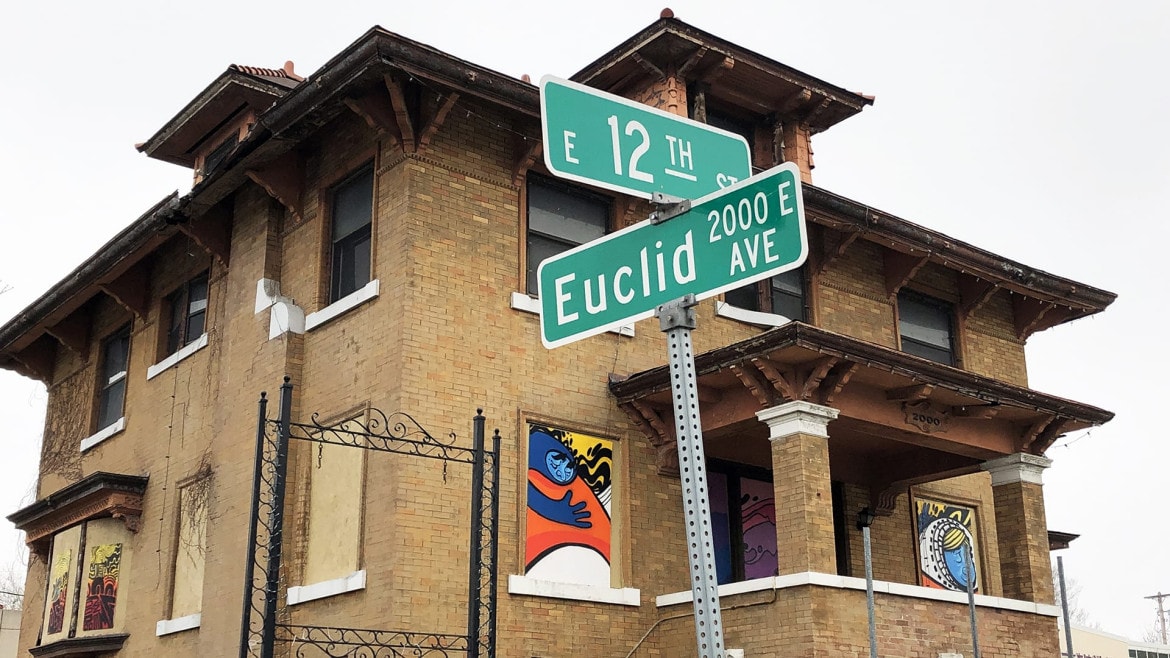United Inner City Services Hope Murals Bring Attention to the Rector House
 The Rector House at 2000 E. 12th St. has a series of new murals designed to draw attention to the historical property. (Jonathan Bender | Flatland)
The Rector House at 2000 E. 12th St. has a series of new murals designed to draw attention to the historical property. (Jonathan Bender | Flatland)
Published May 17th, 2019 at 6:00 AM
Empty houses are still full of stories.
The Rector House sits at 2000 E. 12th St., a two-story brick home with bright swirls of paint on plywood nailed across the windows and doors. The century-old house built for Sarah Rector, once called the “richest Black girl in America,” has been abandoned for nearly a decade.
It’s a building that’s been slowly receding from memory over the last century. Deidre Anderson, the executive director of neighboring United Inner City Services (UICS), wants to make sure it is not forgotten entirely. Anderson is looking for a new beginning with a symbolic splash of color — murals by artist JT Daniels installed on March 22.
“Whatever we do, I think the history here needs to be preserved,” Anderson said. “It’s a question of what’s the best way to honor [Rector’s] story and legacy.”

Sarah Rector was a millionaire by the time she turned 18 years old. A member of the Creek nation, she captivated the country because of her enormous wealth at an early age. Rector’s fortune came from oil rights on land in Oklahoma granted to her by the Treaty of 1866.
After graduating from Tuskegee University, she moved to Kansas City, Missouri, in 1920.
“Early on when Sarah lived at 12th and Euclid she lived large and out loud. She spent money quite freely on the finer things in life, from clothing to cars,” said Tonya Bolden, the author of “Searching for Sarah Rector: The Richest Black Girl in America.”
The house was where Rector started a family. She married Kenneth Campbell and had three children during the decade she lived on 12th Street.
“The Rector Mansion has historical significance because it was once owned by a woman who as a girl was known as the richest black girl in America,” Bolden said.
Anderson has seen a number of changes to the stately brick building next to the United Inner City Services parking lot. The building has been a funeral home and offices for the 12th Street Heritage Development Corporation.
Over the past decade, she’s watched the house slowly fall into disrepair, weeds encroaching on the cement steps and vines climbing up the bricks. Anderson pushed for her organization, a nonprofit that specializes in early childhood education and community arts programs, to acquire the property from St. Mark Union Church two years ago after a tree fell on a UICS employee’s car.
“I know people are wondering what we’re doing with the property,” Anderson said. “Maybe we were a bit naive in what we thought would be (involved) in developing the house.”
Anderson said much of the original woodwork is intact, but copper thieves have stolen the wire out of the walls and vandals broke the leaded glass on the front door. Pigeons rule the attic. The cost of potential renovations and the number of possibilities — a cultural center, historical museum, or economic incubator — has led to a project that has been slow to get off the ground.

UICS has applied for historical and cultural preservation grants to help with the restoration of the Rector House. But while waiting to hear on the status of its applications, they decided to put up plywood murals to help beautify the property and show the city of Kansas City, Missouri, that there was activity at the house.
“It draws attention to the building,” Daniels said. “When a building is blighted, people tend to forget it exists. But now people are paying attention and waiting to see what happens next.”
Daniels work is dotted throughout the city. His murals are in front of Betty Rae’s in the River Market, along the streetcar line, and on the side of the Gem Theater at 18th and Vine.
When he was approached about the project, Daniels, who lives in the Northeast, wanted to represent characters that people might see.
“I focused on community inclusion, multiple people young and old that represent lots of different skin colors without painting in skin colors,” Daniels said.
Gene Willis, the chief engagement officer for United Inner City Services, believes the murals have brought the house into the foreground for the families that come to UICS.
“Students can now see that the house is part of the campus,” Willis said. “They see pictures that look like the community we serve in a world where representation matters.”
For her part, Anderson hopes that this is the just first step toward reclaiming a piece of the city’s history.
“I don’t regret getting the house,” Anderson said. “It’s just been harder than we thought it might be.”


